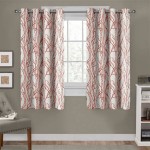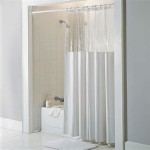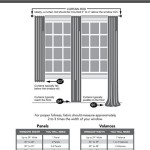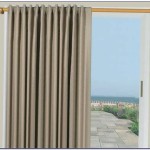Curtain Rods for Corner Windows: A Comprehensive Guide
Corner windows, with their unique architectural appeal, present both aesthetic opportunities and practical challenges when it comes to window treatments. Standard straight curtain rods are simply not equipped to handle the angles and configurations required for effectively dressing corner windows. This is where specialized curtain rods designed specifically for corner installations become essential. Selecting the right curtain rod for corner windows requires careful consideration of several factors, including the window's design, the desired aesthetic, and the functional needs of the space.
This article aims to provide a comprehensive guide to understanding curtain rods for corner windows, exploring the different types available, the key considerations for selection, and installation tips to help achieve a polished and functional window treatment solution.
Types of Curtain Rods for Corner Windows
Several types of curtain rods are specifically designed to accommodate corner windows. Each type offers a distinct aesthetic and functional advantage. Understanding the nuances of each style is crucial for making an informed decision.
Corner Connector Curtain Rods: These consist of multiple straight rods connected by a corner piece. The corner piece is typically adjustable, allowing for varying angles to suit different window configurations. These rods offer flexibility in terms of length and angle, making them suitable for a wide range of corner window setups. The corner connectors themselves can vary in design, influencing the overall aesthetic. Some are simple and functional, while others are more decorative and ornate.
Curved Curtain Rods: Instead of a sharp corner, curved rods provide a smooth, continuous arc. This style is particularly well-suited for bay windows or corners where a softer, more flowing look is desired. Curved rods often require custom bending or pre-fabricated curved sections to match the specific dimensions of the window. The seamless design of a curved rod can create a more elegant and unified appearance compared to connector-based systems.
Track Systems: Curtain track systems offer a more versatile option for corner windows. Tracks can be bent or joined to follow the contours of the corner, allowing curtains to be easily drawn across the entire window area. Track systems are particularly useful for heavy curtains or for creating privacy and light control. They often incorporate carriers or gliders that allow the curtains to move smoothly and silently along the track. Track systems can be mounted to the ceiling or wall, depending on the desired look and the construction of the room.
Telescoping Corner Curtain Rods: These rods typically consist of adjustable sections that slide within one another, allowing for flexible length adjustments. These are often easier to install than other types of corner curtain rods, as they require less precise measurements beforehand. These rods are frequently joined by a corner connector, which can be adjusted for different window angles. While they offer flexibility, telescoping rods may not be as sturdy as fixed-length options, especially when supporting heavy curtains.
Custom-Made Curtain Rods: For unique or complex corner window configurations, custom-made curtain rods may be the best solution. These rods are designed and fabricated to meet the specific dimensions and aesthetic requirements of the space. Custom rods allow for a high degree of personalization, ensuring a perfect fit and a cohesive design. While they are typically more expensive than prefabricated options, custom rods offer unparalleled quality and precision.
Key Considerations When Choosing Corner Curtain Rods
Selecting the appropriate curtain rod for corner windows involves careful evaluation of several factors. Ignoring these considerations may result in an unsatisfactory outcome, both aesthetically and functionally.
Window Configuration and Dimensions: The most crucial factor is the specific configuration of the corner window. Is it a right angle? An obtuse or acute angle? Are the windows the same size, or are they significantly different? Accurate measurements of each window section and the angle of the corner are essential for selecting the correct rod type and size. For complex configurations, it may be beneficial to create a diagram or template to ensure accurate measurements.
Curtain Weight and Fabric: The weight and type of curtains to be used will influence the choice of curtain rod. Heavy curtains, such as those made from velvet or blackout fabrics, require a sturdier rod and more robust mounting hardware. Lightweight curtains, such as sheer or linen fabrics, may be suitable for lighter-duty rods. Consider the weight capacity of the chosen rod to ensure it can adequately support the curtains without sagging or bending.
Aesthetic Style: The style of the curtain rod should complement the overall aesthetic of the room. Consider the finish, design, and detailing of the rod. Options range from sleek and modern to ornate and traditional. The color and material of the rod should harmonize with the curtains and other decorative elements in the room. For a minimalist look, consider a simple, unobtrusive rod. For a more dramatic effect, choose a bolder design with decorative finials or embellishments.
Desired Functionality: The intended use of the curtains will also influence the choice of curtain rod. Are the curtains primarily for decoration, or are they intended to provide privacy, light control, or insulation? For privacy or light control, consider a track system that allows the curtains to be fully closed, eliminating gaps at the corner. For purely decorative purposes, a simpler rod with less coverage may suffice.
Mounting Options and Wall Structure: The type of wall structure and available mounting options should also be considered. Is the wall made of drywall, plaster, or concrete? Are there studs located near the corner? The mounting hardware must be appropriate for the wall type to ensure a secure and stable installation. If mounting to drywall, use anchors to provide additional support. If possible, mount the rod brackets directly to studs for maximum stability. Ceiling mounting may be an option in some cases, particularly for track systems.
Installation Tips for Corner Curtain Rods
Proper installation is crucial for ensuring the functionality and longevity of corner curtain rods. A poorly installed rod can be unsightly and may eventually fail, potentially damaging the curtains or the wall. Following these tips can help ensure a successful installation.
Accurate Measurement and Planning: Before beginning the installation, double-check all measurements and plan the layout of the rod. Use a level to ensure the rod is installed straight and even. Mark the locations of the brackets with a pencil before drilling any holes. Pre-drilling pilot holes can help prevent the wood from splitting, especially when mounting to studs.
Proper Hardware Selection: Use the appropriate mounting hardware for the type of wall being used. Drywall anchors are essential for providing sufficient support when mounting to drywall. Choose anchors that are rated for the weight of the curtains and the rod. Screws should be long enough to penetrate the wall and provide a secure hold. If mounting to concrete, use concrete anchors and drill bits.
Secure Bracket Installation: Ensure that the brackets are securely attached to the wall. Tighten all screws firmly, but avoid over-tightening, which can strip the screws or damage the wall. Check the stability of the brackets before hanging the rod. If the brackets feel loose or wobbly, reinforce them with additional screws or anchors.
Rod Assembly and Placement: Assemble the curtain rod according to the manufacturer's instructions. Carefully slide the rod into the brackets, ensuring that it is properly aligned and centered. If using a corner connector, adjust the angle to match the corner of the window. Secure the rod to the brackets using the provided hardware.
Curtain Installation and Adjustment: Hang the curtains on the rod and adjust their position as needed. Ensure that the curtains hang evenly and that they are properly spaced. If using a track system, test the movement of the curtains along the track to ensure that they glide smoothly. Make any necessary adjustments to the curtains or the rod to achieve the desired look and functionality.
By carefully considering these factors and following these installation tips, one can successfully install curtain rods for corner windows, enhancing the beauty and functionality of their space.

Wrought Iron Corner Curtain Rods Paso Robles Ironworks

Rod Desyne 13 16 Dia Adjustable 120 To 170 Single Corner Window Curtain In Black With Fortune Finials 4872 992 Cr The Home

Emoh 13 16 Dia Adjustable Corner Window Double Curtain Rod 48 To 84 Each Side In Satin Nickel With London Finials H4788 485 Cr The Home

Rod Desyne Lennart Corner 3 4 In Adjustable Curtain Jcpenney

Corner Curtain Rod Connector Heavy Duty Window Wal Com

Our Bedroom Corner Window Curved Curtain Rods Curtains

13 16 Inch Weaver Corner Window Double Curtain Rod 48 84 Satin Nickel 1 Baker S

48 In 84 Adjustable 3 4 Double Corner Window Curtain Rod Satin Nickel With Friedman Finial H4786 485 Cr The Home

Lex Double Corner Window Curtain Rod 13 16 Inch 28 48 Cocoa 1 Fry S Food

Corner Curtain Rods And Ideas For Decorating Around Windows








